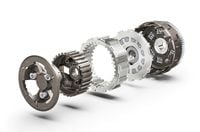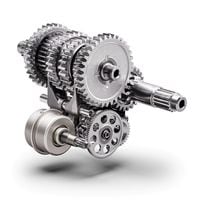It was back in February of 2023 that we got the first clues to KTM’s plan for a new semi-automatic transmission, and now it’s out in the open with confirmation that it’s coming soon to select yet-to-be-announced models. The patent application that first revealed the system turns out to have been an accurate portrayal of the technology that KTM is employing, and while it’s not the first brand to show a new semi-auto transmission this year, it’s a different setup to the recently launched designs from BMW and Yamaha.
The sudden influx of semi-autos means we’ve got a whole barrage of new initialisms from companies keen to distinguish their designs from rival ones. BMW has ASA (Automated Shift Assistant) on the latest R 1300 GS models, while Yamaha’s setup, launched on the MT-09 this year, is Y-AMT (Yamaha Automated Manual Transmission). KTM is going with the simple AMT title for “Automated Manual Transmission” but takes its own path with the technology.
Whereas both Yamaha and BMW use electronic actuators for the clutch and the shifter—essentially allowing computer-operated servos to do the work of your left hand and left foot—KTM’s design does away with the clutch servo and instead uses a centrifugal clutch that automatically disengages when the engine’s speed drops to idle. The shifts are then completed via an electromechanical actuator that changes cogs in as little as 50 milliseconds, assisted by engine controls similar to those used with a conventional quickshifter to match the engine revs and allow the gears to change smoothly.
The adoption of a centrifugal clutch, as shown in last year’s patent, requires the addition of a “Park” setting using a pawl that engages inside the gearbox to lock it when the bike is parked and you don’t want it to roll. That’s because you can’t simply leave it in gear, as you would on a conventional bike, because the clutch defaults to a disengaged position. Since there’s no direct mechanical connection between your left foot and the shift forks, the gear sequence has also been modified, and instead of 1-N-2-3-4-5-6 like a conventional bike, the pattern is P-N-1-2-3-4-5-6.
As on other semi-autos, the shifting can be done in a fully automatic mode, letting the computer decide when to change ratios and letting you swap between three shift programs (Comfort, Street, or Sport) to control when those shifts take place. At any time, though, you can override the transmission using the shift paddles on the left bar—your hand’s free as there’s no clutch lever—or an electronic shift pedal that mimics a conventional one at your left foot. Making a manual shift suppresses the auto shifting for four seconds. There’s also a “kickdown” when you snap the throttle open, or you can prompt a downshift by quickly closing the throttle before opening it again, which KTM claims makes overtaking easier.
The system is also tied into the Adaptive Cruise Control (ACC) fitted to some bikes, allowing them to follow a vehicle to a complete standstill. If the vehicle ahead moves away in less than three seconds, the bike will automatically accelerate as well, while you can resume after longer stops by manually accelerating or pressing the Resume button.
The foot shifter works the same as the bar-mounted paddles, just with a more conventional feel and action that manual bike riders will be familiar with. However, because it’s really nothing more than an electronic switch, the shift pattern can be easily changed between a conventional orientation (up for upshifts, down for downshifts) to a reversed, race-style pattern (down for up, and up for down). The electronics mean that the system can automatically prevent over revving, not allowing you to move into an inappropriate gear, and the foot pedal can’t select park or neutral (those functions are on the bar pod only), so there’s no risk of finding a neutral when you don’t expect it. You can also activate or deactivate a “High Rev Limiter Shifting” option, which will let the bike upshift automatically when you’re going to hit the rev limiter, even in manual mode.
While KTM has yet to confirm which bikes the system will be offered on, the setup was tested on a prototype 1390 Super Adventure at the Erzbergrodeo earlier this year. The system has so far only been illustrated on KTM’s big V-twin engines, both in the original patent and the new photographs of the design, suggesting those will be the models that benefit first, although there’s little reason that the same setup couldn’t be adopted on KTM’s smaller parallel twins or even single-cylinder machines in the future if there’s demand for it.













/cloudfront-us-east-1.images.arcpublishing.com/octane/HO74AMHWPFCUHKZ6JZV7R2UQFA.jpg)
/cloudfront-us-east-1.images.arcpublishing.com/octane/H6FFG4YQMREO3DTADIJMECNS7Y.jpg)
/cloudfront-us-east-1.images.arcpublishing.com/octane/QCUUDRRAIFHDDGB5OTZVKUS554.jpg)
/cloudfront-us-east-1.images.arcpublishing.com/octane/RBDRR2OHFFBPRNXW6V3FN2SNAM.jpg)
/cloudfront-us-east-1.images.arcpublishing.com/octane/EFFSPCZVBBCMTNGVEQMB7NNKIU.jpg)
/cloudfront-us-east-1.images.arcpublishing.com/octane/5GP3PUGFKVGUVCEYG4ZBDYLNBE.jpg)
/cloudfront-us-east-1.images.arcpublishing.com/octane/USTSFGXT3ZGL7BT7B66WMSSKTI.jpg)
/cloudfront-us-east-1.images.arcpublishing.com/octane/Z7YU6FSR6NEKVMKT5CZPMKIVLE.jpg)
/cloudfront-us-east-1.images.arcpublishing.com/octane/MOP35BTV3FFANFBUJKU2RJRTZ4.jpg)
/cloudfront-us-east-1.images.arcpublishing.com/octane/UWTN4NTIJFD25MPXBOVS4DFOXE.jpg)
/cloudfront-us-east-1.images.arcpublishing.com/octane/SIFOY54XMFGEHAUYNFUYVW7IZ4.jpg)
/cloudfront-us-east-1.images.arcpublishing.com/octane/HMC5X3JZHRASXGVCVNBJBWWGSI.jpg)
/cloudfront-us-east-1.images.arcpublishing.com/octane/UIWGXRZDM5HZXJOWXET2DZIWJE.jpg)
/cloudfront-us-east-1.images.arcpublishing.com/octane/QSS5DZ6SKJEU3AKE4KDAWYBEFY.jpg)
/cloudfront-us-east-1.images.arcpublishing.com/octane/SMCEQCLWRVEFTJJES6TAHB3OOQ.jpg)
/cloudfront-us-east-1.images.arcpublishing.com/octane/JCACIDCAC5FUNPTXO2BOUHGGII.jpg)
/cloudfront-us-east-1.images.arcpublishing.com/octane/DC7ZGILA2BCJXHZIUNYGV7JSEA.jpg)
/cloudfront-us-east-1.images.arcpublishing.com/octane/EWJEZUGWEZGABDEQWB64WL46GQ.jpg)
/cloudfront-us-east-1.images.arcpublishing.com/octane/5NHBMRMSFVD5JAPFNMBMNPGXQE.jpg)
/cloudfront-us-east-1.images.arcpublishing.com/octane/WHE43SCPLJBRNANAJAGXHOAIEU.jpg)
/cloudfront-us-east-1.images.arcpublishing.com/octane/6R56AQAW6NDE7BBIJ3SMCOOY5A.jpg)
/cloudfront-us-east-1.images.arcpublishing.com/octane/JMQTUE2FKZFURJTJXDMM4V47AQ.jpg)
/cloudfront-us-east-1.images.arcpublishing.com/octane/P2QYJDMQNVEANMQFXHNB3OVFKQ.jpg)
/cloudfront-us-east-1.images.arcpublishing.com/octane/VNKGXM4AA5BPRGERJOPV6GADAQ.jpg)
/cloudfront-us-east-1.images.arcpublishing.com/octane/2WS4YIFLTNG25L25WP7ZFLSWJM.jpg)